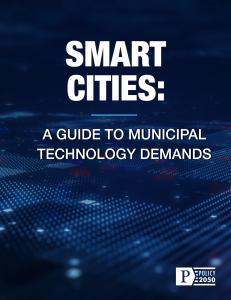
For innovation to align with infrastructure, technology providers must present well-articulated, data-driven efficiencies, according to a new Policy2050 report.
SAN FRANCISCO, CALIFORNIA, USA, August 4, 2023/EINPresswire.com/ — Policy2050.com, a boutique market research firm at the intersection of technology, public policy, and forward-thinking business strategy, has released a new report: “Smart Cities: A Guide to Municipal Technology Demands.” This report is the companion to another recent release, titled “Smart Cities Decoded: Analysis of Technology Providers, Risks, and Opportunities.”
The new report will help tech companies analyze the procurement needs and non-functional requirements of municipal stakeholders. City governments themselves may also derive value by studying contemporaries.
As cities grow, there’s an increasing emphasis on transparent, data-driven decision-making, evidenced by initiatives like NYC Open Data, DataSF, and Dublinked. Visualizing data-driven efficiencies within the Smart City framework can be helpful when engaging with municipal leadership since the very concept of a “Smart City” is already abstract and subject to a range of interpretations.
For instance, to break down its intricate value proposition, Schneider Electric employs a pyramid diagram. At its base, the age-old legacy systems and ICT devices operate, constituting what the company refers to as “the true operating technology level of a city.” Optimizing these systems is considered to be a realistic first step toward improving fundamental performance and preparing for integrations with newer systems further up the pyramid.
For Schneider Electric’s implementations, this process entails SCADA architectures, smart panels, switchgear, transformers, etc., which are controlled through a higher edge computing layer. Ultimately, the pinnacle of this pyramid combines information technologies (IT) and operating technologies (OT), granting municipal service operators a panoramic view of actionable analytics.
Smart City implementations must balance the technical need for modernization with budgetary constraints, necessitating a multi-dimensional and oftentimes modular approach. Smart City technology providers should also account for usability, which includes intuitive design and user satisfaction, as well as scalability, ensuring platforms can handle growing demands without compromising performance.
AI, with its unparalleled computational prowess and predictive capabilities, is primed to usher us into an epoch where governance is not just influenced by data but primarily responsive to it. Eventually, the value of ideologies and instincts may be challenged.
However, this futuristic vision is not devoid of formidable challenges. AI could exacerbate hard-to-extract encoded biases, leading to controversies, or be cited as an “unbiased” source to mitigate controversies. Moreover, to access the full potential of AI, cities must invest in robust digital and physical infrastructures that can support the voluminous data influx, rigorous computations, and interconnectivity that AI demands. The financial, technical, and human capital investments required are substantial, necessitating strategic planning, collaboration, and a commitment to long-term sustainable development. As we stand on the precipice of this AI-driven era, the decisions and investments made today could lead to even better decision-making tomorrow.
In the meantime, to adeptly navigate the “Smart Cityscape,” technology providers must first appreciate the nuances of effective communication, especially when interfacing with the esteemed leaders of city governments. By framing their avant-garde products and services through the prism of data-driven efficiencies, technology leaders can make these concepts more palpable.
An efficient, interconnected, and dynamic data ecosystem works to support resilience and adaptability in city infrastructure. A unified focus on data security, privacy, and regulatory compliance shows an understanding and respect for the seriousness of these endeavors, further cements new alliances, and works to thwart bad actors and negative outcomes. A commitment to training and support ensures that unique value propositions lead to full value delivery.
The confluence of these pivotal tenets transcends the traditional vendor-client relationship, leading instead to a digital partnership characterized by innovation, trust, and service of communities. Together, with an aligned vision and mutual dedication, experts from the domains of innovation and governance can reimagine the blueprint for tomorrow’s urban utopia.
###
ABOUT POLICY2050.COM
Policy2050.com provides business news and analysis. We seek to influence the future of tech policy and business strategy in order to bring about a sustainable, fair, and vibrant economy.
David Pring-Mill
Policy2050.com
david.pringmill@policy2050.com
![]()



